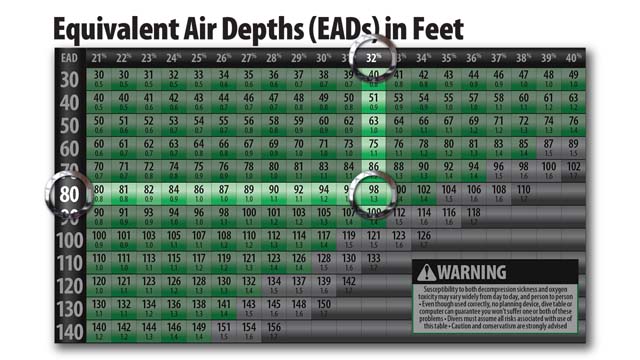How Henry’s and Dalton’s Laws Affect Us

In this section, we discuss:
- Henry’s Law and On-Gassing
- Dalton’s Law and On-Gassing
- Dalton’s Law and Narcosis
- How does Henry’s Law affect on-gassing?
- How does Dalton’s Law affect on-gassing?
- Does Dalton’s Law affect narcosis?
Henry’s Law and On-gassing
As pressure increases, inert gas dissolves in our body tissues in direct proportion to the pressure and time we remain at depth, in accordance with Henry’s Law. Simply stated, the deeper you go and the longer you stay, the more inert gas your body absorbs. This also means you have more dissolved gas that you must off-gas on the surface.

Henry’s Law provides a framework for explaining why dive tables and computers give you less bottom time the deeper you go. Because your body absorbs more gas as it goes deeper, the more gas you have to release as you surface.
Consequently, you need to ascend at 10 m/30 ft per minute or slower to manage off-gassing. Since you have more dissolved gas in your system, surface intervals will need to be longer to provide adequate time to return to normal partial pressures and/or repetitive dives need to be shorter since you have above-normal levels of gas still in your system.
Dalton’s Law and On-Gassing
We can use Dalton’s Law to “cheat” our way around Henry’s Law. Dalton’s Law provides a framework for understanding partial pressures of individual gases in a mixture and the effects of the gases on the body which, in turn, allows divers to plan safe dives using Nitrox and other gas mixtures.

Remember, although we are referring to “inert” and “dissolved” gas, we really mean nitrogen and, in the case of more advanced technical dives, helium. Using Nitrox as an example, if we reduce the concentration of nitrogen in the mix, thus reducing the partial pressure of nitrogen at depth, we reduce the amount of nitrogen uptake. That is why Nitrox allows us longer bottom times and shorter surface intervals when compared with the use of air for the same depth and time.
Reducing the concentration of nitrogen doesn’t completely negate Henry’s law — but does reduce the impact of the inert gas.
Dalton’s Law and Narcosis
If you took the NASE Advanced Nitrox Diver or a similar course, you learned about the concept of Equivalent Air Depth (EAD). Equivalent Air Depth is a way of comparing a depth reached while diving Nitrox to a depth reached while diving air that would expose divers to the same overall level of nitrogen absorption and nitrogen partial pressures. Simply stated, diving Nitrox at a particular depth is like diving air at a shallower depth.
For example, breathing EAN32 at 30 m/100 ft exposes you to roughly the same partial pressure of nitrogen as a dive to 24 m/80 ft while breathing air.

At this point, you may be thinking Reduced partial pressures of nitrogen should also mean reduced narcosis…right? It’s a nice theory. In fact, it would be true, were it not for one thing: There is evidence to suggest the oxygen in Nitrox may be every bit as narcotic as the air.
In the early days of Nitrox, it was widely held that Equivalent Air Depth and Equivalent Narcotic Depth (END) were one and the same. Now we know better. The only way to make Equivalent Narcotic Depth less than actual depth is by adding helium, which is not narcotic, to the mix — which is why advanced technical dives generally involve the use of Trimix.
Key Points to Remember
- According to Henry’s Law, the deeper you go and the longer you stay, the more inert gas you absorb into your tissues.
- Dalton’s Law provides a framework for understanding partial pressures of individual gases in a mixture which in turn allows divers to plan safe dives using Nitrox and other gas mixtures.
- In so far as nitrogen and oxygen may be equally narcotic, Dalton’s Law can only be used to reduce narcosis if you add helium to the breathing mixture.
Learn More on Wikipedia
